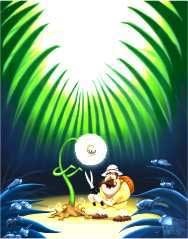
Springtime means many things—warmer weather, switching from clunky boots to sandals, picnics and baseball—but it also signifies the start of many weeks of arduous work toward the ultimate goal of creating a lush, beautiful turf. Unfortunately, waiting underground, ready to ruin that flawlessly manicured landscape, are mean green aliens—otherwise known as weeds. Cutting, spraying and mowing seems to temporarily keep them at bay, but eventually they rear their ugly head again. Can weeds really be tamed?
The question should really be—do you really want to tame your weeds? The wise A.A. Milne, author of the famed Winnie the Pooh classic series, once wrote, "Weeds are flowers too, once you get to know them." Even Ralph Waldo Emerson penned the thought, "What is a weed? It is a plant whose virtues have not yet been discovered."
A Weed is a Weed is a Weed?
Beautiful prose aside, experts such as Barbara J. Bromley, the Mercer County horticulturist in Lawrence, actually agree with the writers much of the time.
"Weeds are really just plants growing where you don't want them to grow," she says. "Even a tomato plant growing in a corn field is considered a weed. It's just that weeds that homeowners associations' find objectionable—like dandelions - are going to be a problem to them."
Associations may have to deal with many kinds of tough, stubborn weeds germinating on their property—with crabgrass and dandelions leading the pack—but even with their budding virtues, most lawn caregivers do not want to get to know the interlopers. Instead, they want speedy solutions for elimination.
In order to remove them, however, Bromley says that you must first educate yourself on the types of weeds, so you can choose the best method of prevention.
"It's not as simple as 'I have a weed, how do I get rid of it?'" she says. "It's much more involved than that. You need to understand weed management and turf and learn the classification of weeds."
Bromley breaks down this weed classification as follows: annuals, which live, set seed and die in the same year; biennials, which grow vegetatively first and the next year grow again, flower, set seed and die; and perennials, which live longer than two years. Breaking it down further, there are annual weeds that are grasses (such as goose grass) and then broadleafed weeds.
"The reason it's important to know whether your plants are grasses or broadleafed, for example, has to do with the kind of weed killers they sell," says Bromley. "If you have a product like Weed-B-Gon, for example, it is a selective weed killer so it will selectively remove a broadleafed plant from the lawn. Other products are not selective and will kill both grasses and broadleafed plants, so you have to be careful with weed killers and know what kind of plants you're trying to get rid of."
Whence Cometh this Weed?
It's also important to learn how the weeds got there to begin with. How does a weed show up where it's not wanted?
"Weeds are indicators of poor turf management, such as low organic matter and nutrients, compacted soil, too much shade or too hot and dry," says Laurie Broccolo, an ISA Certified Arborist, Certified Nursery Professional, and the chief executive officer of Broccolo Tree & Lawn Care in Rochester, New York.
Weeds can also be transported from one property to another through other plants and lawn care equipment.
For example, Bromley considers Japanese stilt grass to be, what she calls, an 'annual horror' to properties in New Jersey that suffer from it. "It looks like grass, will grow anywhere and is very difficult to control," she says. "The problem is that this grass can be carried to the property through containers of plants that are brought in, soil or even mulch. There are all kinds of ways to bring it in without knowing you're bringing it in - from gift plants or swap plants that have a few of the seeds."
According to the National Park Service's website http://www.nps.gov/ plants/alien/fact/mivi1.htm, Japanese stilt grass has a "sprawling habit and grows slowly through the summer months, ultimately reaching heights of two to three-and-a-half feet. The leaves are pale green, lance-shaped, asymmetrical, long, and have a distinctive shiny midrib. Slender stalks of tiny flowers are produced in late summer; around August or September…it threatens native plants and natural habitats…it spreads to form extensive patches, displacing native species that are not able to compete with it."
Lawn care equipment is also a principal culprit in weed procreation.
"Weeds are like communicable diseases, they get carried from one property to another through the lawn equipment," says Brian Helgoe, garden maintenance advisor for ValleyCrest Companies in Calabasas, California.
"Your lawn company should wash off the deck of the mower between cuttings. Very smart HOAs, when they sign contracts with lawn companies, will put it in the contract that all mower blades will be washed before they are used on their property. Other HOAs will require that the company uses only their equipment on-site."
Repeat Offenders
Helgoe considers yellow nutsedge to be one of the most troublesome weeds. "It's like a hydra (monster with nine heads; when struck off each head was replaced by two new ones) - many more will come up afterwards," he says. "It's found in flower beds too and is hard to see. You don't know it's there and you keep mowing it, but it will be a few seasons before you get rid of it."
According to Bromley's online fact sheets at www.mgofmc.org/nutsedge. html, "Yellow nutsedge (cyperus esculentus), a perennial, is a grass-like sedge that can infest lawns and landscape beds in warm weather. In one growing season a few plants may be replaced by large patches of the pest," she writes. She recommends removing them by hand, repairing damaged areas and improving drainage where water collects.
"Yellow nutsedge may be control1ed chemically by one or more applications of products such a Finale and Roundup, which can be used as a direct spray on individual plants, but have the potential to injure ornamental plants and will kill turfgrass," she writes.
Dandelions and crabgrass are two of the most notorious, persistent weeds on New Jersey turf (unless, of course, you live in Vineland, New Jersey, the self-proclaimed "dandelion capital of the world" for the dandelions they produce are used as salad greens and in wines). The dandelion is a perennial, herbaceous plant with long, lance-shaped leaves. They're very deeply toothed in the soil.
Crabgrass is an annual grass that appears in the warm season with stubborn roots that are difficult to eradicate. It's so bad that humor columnist Dave Barry once wrote, "Crabgrass can grow on bowling balls in airless rooms, and there is no known way to kill it that does not involve nuclear weapons." Well, almost…
"Crabgrass germinates and spreads from the seeds, so if you can prevent the seed from coming up, you won't have problem," explains Bromley. "It also needs the light of the sun to germinate. So if you have bare spots because you edge or if there are dead spots, those areas are where crabgrass will be most happy. It germinates in the middle of April and May and continues until July, as long as the soil is warm and moist. One method of prevention is to maintain a minimum mowing height of 3 inches and maintain a dense turf."
Broccolo rounds out her list of worst weeds as follows: tall fescue, bentgrass, moss, ground ivy, clover, veronica, common speedwell, and chickweed.
Nipping the Buds
Regardless of the enemy, the bottom line for all weed prevention isn't tackling the problem once it surfaces, but implementing good lawn care practices before any problems erupt.
Lance Walheim, co-author of Lawn Care for Dummies and Landscaping for Dummies,describes those good practices as proper mowing, watering and fertilizing. "There are some organic preemergents - like corn gluten, for example - that prevent weed seeds from germinating," he says. "But they can be hard to find. Obviously, you can hand pull weeds as well, but the timing has got to be precise when you're controlling weeds."
He suggests using a preemergent around March. Check the label for specific timing and if weeds are present, he recommends Bayer Advanced All-In-One Lawn Weed & Crabgrass Killer or Bayer Advanced All-In-One Weed Killer for Lawns which, he claims "are the only products that kill both crabgrass and broadleaf weeds like dandelions. Read specific guidelines on the labels about when to use such products."
Keep the suffix "cide" in mind when you are looking at post-emergence products to treat the already existing problems. "With herbicides and fungicides, don't assume anything - some are less toxic than others," says Bromley. She also advises being particularly careful and conscientious when using products with the words, 'caution,' 'warning' and 'danger' on the label. Heavy artillery chemicals like DDT are no longer legal, but even today's gentler pesticides and herbicides can have negative effects on plants, animals, and people.
No Magic Bullet
Learning about the weeds and how to treat them will prevent future outbreaks, but be careful not to look for a cure-all, spray-the-entire-lawn type of treatment.
"One of my major objections in this world—and one any management company can think about - is, why in this world would you put weed killer over turf if your weed problem is only sporadic," says Bromley. "Unless the whole lawn is in serious trouble, in which case you'd do a one-time total weed population control one year and spot treat the next."
The same good practices for weed prevention will also prevent any other lawn diseases that may crop up, but if you spot any other lawn problems, it's usually wise to consult a landscape expert. In the end, solving your worst weed problems is much like any other issue that arises in an association—competent professional help early on can help prevent major problems down the road.
Lisa Iannucci is a freelance writer living in Poughkeepsie, New York and a frequent contributor to The New Jersey Cooperator.






Comments
Leave a Comment